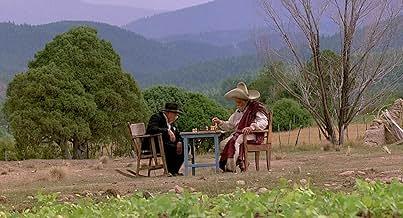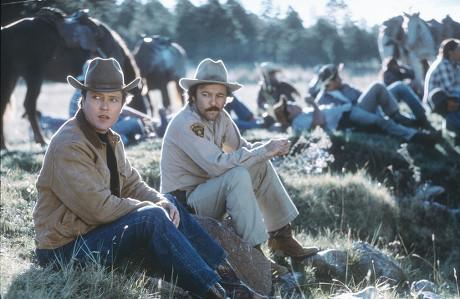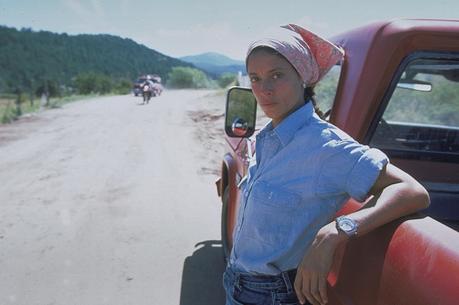
Old Man Amarante "speaking" to Coyote Angel (at right) in The Milagro Beanfield War (1988)
In honor of National Hispanic Heritage Month, which takes place each year between mid-September and mid-October, I would like to recommend a film that was featured recently on the Turner Classic Movies (TCM) network: The Milagro Beanfield War from 1988.
Directed by actor and producer Robert Redford and starring a large and colorful group of actors and non-actors, the production was shot on location in and around the northern New Mexico region of the Southwest.
Based on the acclaimed 1974 book of the same name by American novelist John Nichols, with a screenplay by Nichols and David S. Ward ( The Sting, Sleepless in Seattle), The Milagro Beanfield War first saw the literary light of day as part of a trio of books (dubbed the "New Mexico Trilogy") that included The Magic Journey (1978) and The Nirvana Blues (1981).
Basically, the film's premise concerns a protracted battle for water and land rights (shades of Polish-born director Roman Polanski's Chinatown, but nowhere near as cynical) - mostly by greedy speculator Ladd Devine - to a drought-stricken, seemingly worthless piece of property called Milagro ("Miracle," aka the Miracle Valley Recreation Area).
Shrugged off as dusty and totally without value, Devine gets many of the locals to support his efforts at building a dam as well as constructing a housing/recreational development - with, of course, the signing over to him of the inhabitants' land and mineral rights. When it's learned that illegal irrigation has made the formerly useless property fertile - resulting in a bountiful bean crop (one of several "miracles" that pop up throughout the picture) - the race is on to see who can stop the greedy developers from taking over the locals' territory.
Sprinkled about like cilantro are a series of random sequences that give bite, flavor and depth to Milagro's quirky rifle-toting residents and their various traditions. One can easily relate much of the plot to today's polarized environment which, to wit, pits the so-called "haves" with the rustic "have nots."

A large number of familiar faces populates the production, among them Panamanian actor-singer Rubén Blades as the lowkey Sheriff Montoya; Richard Bradford as avaricious developer Ladd Devine; Brazilian Sonia Braga as the driven Ruby Archuleta who keeps herself occupied by getting the residents to sign a petition against the developer; John Heard as Charles Bloom, a socially conscious, but laidback big city lawyer whom Ruby only has eyes for; Melanie Griffith as Devine's ditzy spouse Flossie; Daniel Stern as East Coast sociologist Herbie Platt studying the region's customs; Chick Vennera as plucky ne'er-do-well Joe Mondragon; and a youngish Christopher Walken (of all people!) as Kyril Montana, a hired gun out to apprehend the mischievous Mondragon.
I've barely covered the comings and goings of this delightful serio-comic romp. But among the pleasures I personally derived from it are appearances by veteran Mexican film actor Carlos Riquelme as wise old Amarante Cordova, whose grumpy repartees with Coyote Angel (Robert Carricart), a ghostly Pancho Villa-like apparition, are a major asset; Montana's daunting pursuit of the escaped Mondragon over treacherous terrain; the laughable attempt at abducting a stubbornly resistant cow from its peaceful pasture by the town's Mayor Sammy Cantu (Tejano singer-actor Freddy Fender); and a crowd-pleasing finale (what else?) where - you guessed it! - everyone sings and dances away their troubles in an "all's well that ends well" conclusion.
Readers may have picked up on the curious, if not offbeat selection of a native Brazilian in the part of a Mexican advocate for people's rights. This came about due to Ms. Braga and Mr. Redford having been an on-again, off-again "item" for several years. More to the point, Braga, whose niece also happens to be actress Alice Braga ( City of God, I Am Legend, Predators), began her career on Brazilian television in a children's show, Jardim Encantado ("The Enchanted Garden"). In the early 1970s she appeared on Vila Sésamo, Brazil's version of Sesame Street. Braga went on to star in a hit TV series of Bahian modernist writer Jorge Amado's Gabriela, Clove and Cinnamon (1972). A few years later, director Bruno Barreto made a successful movie adaptation of another Amado novel, Dona Flor and Her Two Husbands.

Actress Sonia Braga as Ruby Archuleta in The Milagro Beanfield War (1988)
Interestingly, both the Dona Flor book and movie involved something The Milagro Beanfield War effectively capitalized on - and that is, a whimsical tale that smacks of an earlier literary category identified as "magical realism," which first captured the reading public's imagination in the works of Franz Kafka ( The Metamorphosis) and later by Colombian author Gabriel García Márquez ( One Hundred Years of Solitude, Love in the Time of Cholera).
Despite the multitude of characters and the (at times) somewhat congested storyline, the main emphasis that viewers can come away with is the strong presence of family and - more importantly - the strength that people can derive from their culture and their collective sense of community.
Personally speaking, the biggest thrill that I got from The Milagro Beanfield War was actual location footage of the rugged New Mexico topography, along with practical FX and stunts, with such items as real vehicles, real tractors, real smoke and dust and heat; purple sunsets and golden sunrises, clouded skies, and muddy streams; and an actual beanfield with real-life foliage and plants. Instead of seeing CGI-created shrubbery that are nowhere near what outdoor locations are supposed to be like, in sum the tactile sense of a naturally occurring environment gave a positive lift to the story by way of ambience.
Another welcome feature was jazz pianist and composer Dave Grusin's atmospheric music score to accompany the various goings on. This film is highly recommended for those culturally sensitive souls (along with us nostalgia buffs) who are curious enough to experience something totally different from what one has been used to - even if it's just a movie!
Copyright © 2024 by Josmar F. Lopes
